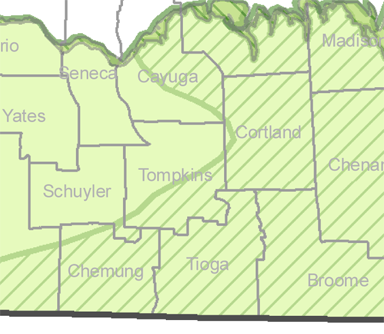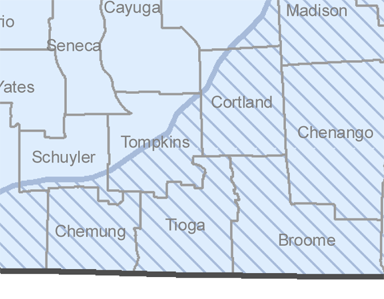September 22, 2011
Fairways (for drilling, not driving)
I mentioned earlier that Dryden is at "an interesting geological location", but hadn't gone into much depth about why.
The first half of the geological section of the New York State draft SGEIS (4.2MB PDF) explores the question of where the two key shales containing natural gas, the Marcellus and the Utica, might be. So far, we've mostly heard about the Marcellus, which is closer to the surface, but the Utica gets about as much attention in the SGEIS.
I guess geologists or drilling companies must be golfers, because the area in which you can best drill a given formation is called a "fairway". The SGEIS looks at a variety of factors, including the depth and thickness of the formations and their organic matter content to estimate where these fairways are.
The maps in the SGEIS are drawn to include all of Upstate New York, and given their nature, the boundaries they suggest are fuzzy anyway. However, they do give a rough estimation of what the likely drilling areas look like.
For the Marcellus Shale, the fairway cuts across Dryden such that the eastern and southern parts of Dryden are inside the edge, while Freeville and West Dryden are likely outside.

Marcellus Shale Fairway (area with lines), south-central New York State.
You'll want to read the full chapter for details on why the line is drawn this way. In Dryden, we seem to have a combination of:
- depth
2000 to 3000 feet down
- thickness of the organic-rich layers
125-175 feet
- total organic carbon
4.5 - 5.5% by weight here, some of the highest carbon in the formation
- vitrinite reflectivity, indicating thermal maturity
"greater than 3.0"
That thickness may be too low to be ideal, and the vitrinite reflectivity, "a measure of the maturity of organic matter in rock with respect to whether it has produced hydrocarbons", too high. As the SGEIS puts it:
Values of 1.5 to 3.0 % Ro are considered to correspond to the "gas window," though the upper value of the window can vary depending on formation and kerogen type characteristics. (4-16)
From looking at the maps and reading the descriptions, it sounds like the western boundary of the fairway is uncertain at best. There's a lot of organic matter in this shale underneath Dryden, but it may also be kind of overcooked.
Update: Now I wonder more about how clear this fairway designation is.
The Utica Shale fairway includes more of Dryden, probably everything except the northwest corner.

Utica Shale Fairway (area with lines), south-central New York State.
There's less detail on the Utica Shale, perhaps in part because of its greater depth. In Dryden, it seems to be around 7000 feet down. The contour lines in Figure 4.6 of the SGEIS suggest a thickness in Dryden of 50-100 feet of high organic carbon shale. With less information, they took a fairly simple approach to defining the fairway:
Based on the available, limited data, Nyahay et al. (2007) concluded that most of the Utica Shale is supermature and that the Utica Shale fairway is best outlined by the Flat Creek Member where the TOC and thickness are greatest. This area extends eastward from a northeast-southwest line connecting Montgomery to Steuben Counties (Figure 4.7). The fairway shown on Figure 4.7 correlates approximately with the area where the organic-rich portion of the Utica Shale is greater than 100 feet thick shown on Figure 4.6.20 The fairway is that portion of the formation that has the potential to produce gas based on specific geologic and geochemical criteria; however, other factors, such as formation depth, make only portions of the fairway favorable for drilling. Operators consider a variety of these factors, besides the extent of the fairway, when making a decision on where to drill for natural gas. (4-13)
There is also another deeper formation not covered in the SGEIS, the Trenton-Black River formation, which is at least theoretically drillable in Dryden. From conversations with landowners, it seems that many of the leases in the area were signed with that formation as the suggested target, and the Cook 1 permit application was originally for that formation.
However, Anshutz, in its lawsuit filing, omits the Trenton-Black River. In Section 7, Parties, they write:
It will, therefore, have lost its investment in acquiring its oil and gas leases through geological assessments as well as a loss in development opportunity by being prevented from drilling in an area believed to be prospective for Marcellus and Utica shales.
I was surprised that they didn't mention the Trenton-Black River, but then they're the ones with the seismic data to indicate whether that's feasible here. Perhaps it isn't, or perhaps it might only make senseto their accountants as part of a larger drilling operation that already puts much of the expensive infrastructure in place. The DEC map shows activity mostly to our west. However, this Introduction to New York's Trenton / Black River Play from the New York State Museum suggests that it might be feasible here, though the data for Tompkins County is thin.
Posted by simon at September 22, 2011 12:29 PM in Anschutz lawsuit , energy , geology , mapsNote on photos
You mention that the Utica is "supermature" in the Dryden area - that's actually a big negative for gas drilling. It means that the shale is over-mature, which essentially means non-commercial. The Marcellus may also be over-mature, but given the shallow drilling depths, it would have very limited commercial value in our area regardless. Anshutz was indeed drawn to Dryden by Trenton Black River potential, but at current gas prices, that's a loser too. This helps explain why they filed suit - they hoped the courts would bail them out of what turned out to be a bad investment. Dryden just isn't a promising place to drill for oil and gas given the current state of the gas markets and the geology of the shales we have here. I would be very surprised if a single profitable well got drilled in the Town over the next 20 years even without a drilling ban in place. The gas just isn't here.